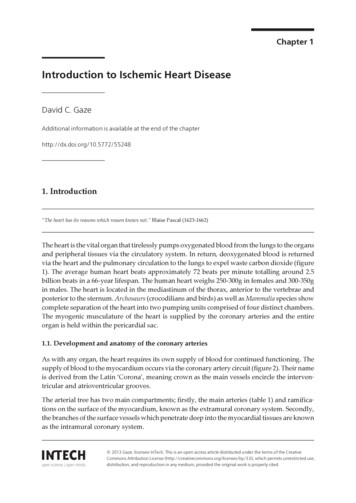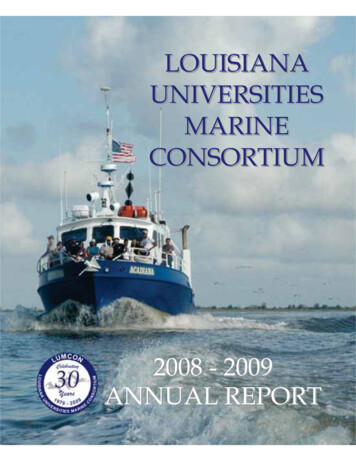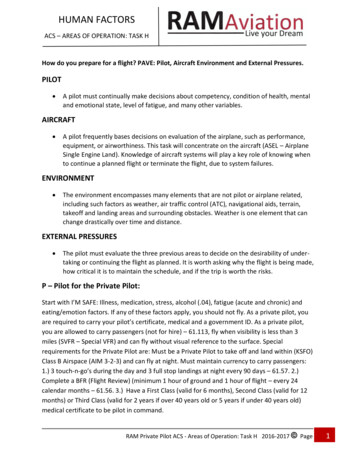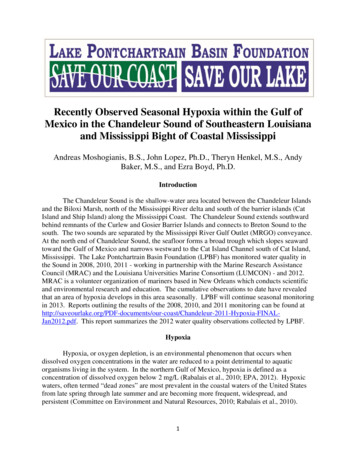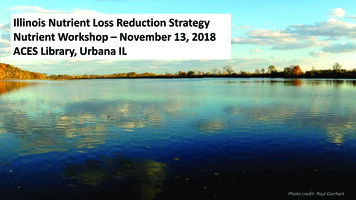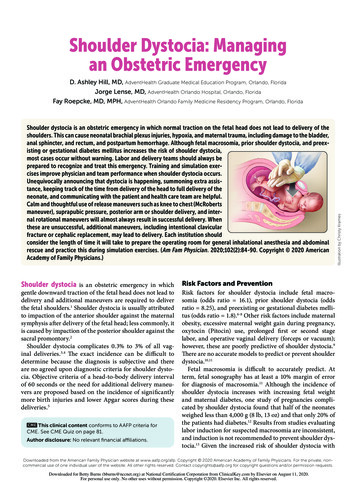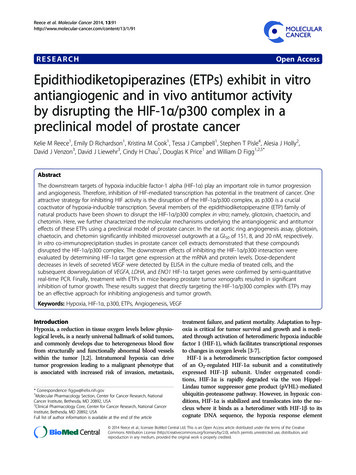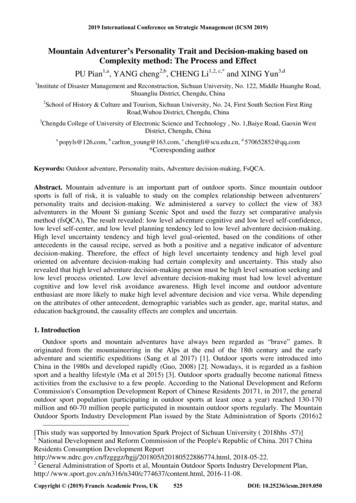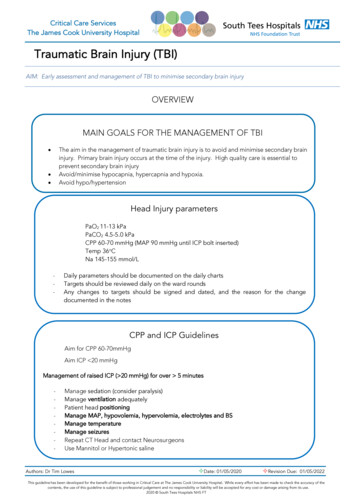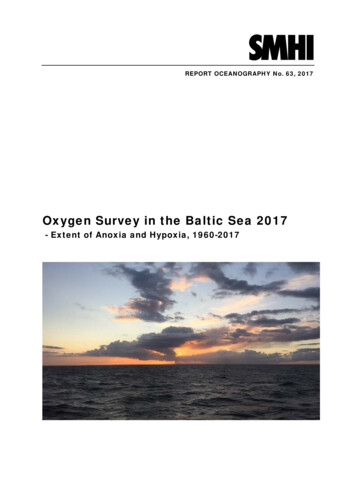
Transcription
REPORT OCEANOGRAPHY No. 63, 2017Oxygen Survey in the Baltic Sea 2017- Extent of Anoxia and Hypoxia, 1960-2017
Front: The photo was taken on-board M/S Meri during SMHIs September cruise in 2017 somewhereeast of Gotland.ISSN: 0283-1112 SMHI
REPORT OCEANOGRAPHY No. 63, 2017Oxygen Survey in the Baltic Sea 2017- Extent of Anoxia and Hypoxia, 1960-2017Martin Hansson, Lena Viktorsson & Lars AnderssonSwedish Meteorological and Hydrological Institute, Göteborg, Sweden
SummaryA climatological atlas of the oxygen situation in the deep water of the Baltic Sea was firstpublished in 2011 in SMHI Report Oceanography No 42. Since 2011, annual updates have beenmade as additional data have been reported to ICES. In this report the results for 2016 havebeen updated and the preliminary results for 2017 are presented. Oxygen data from 2017 havebeen collected during the annual Baltic International Acoustic Survey (BIAS) and from nationalmonitoring programmes with contributions from Sweden, Finland and Poland.For the autumn period each profile in the dataset was examined for the occurrence of hypoxia(oxygen deficiency) and anoxia (total absence of oxygen). The depths of onset of hypoxia andanoxia were then interpolated between sampling stations producing two surfaces representingthe depth at which hypoxic and anoxic conditions respectively are found. The volume and areaof hypoxia and anoxia have been calculated and the results have then been transformed to mapsand diagrams to visualize the annual autumn oxygen situation during the analysed period.The updated results for 2016 and the preliminary results for 2017 show that the severe oxygenconditions in the Baltic Proper after the regime shift in 1999 continue. Both the areal extent andthe volume with anoxic conditions have, after 1999, been constantly elevated to levels onlyobserved occasionally before the regime shift. Despite the frequent inflows to the Baltic Seaduring the period 2014-2016 approximately 18% of the bottom area was affected by anoxia and28% by hypoxia during 2017. The hydrogen sulphide has, due to the inflows, disappeared fromthe Eastern and Northern Gotland Basin. However, the oxygen concentrations in the deep waterare still near zero and signs of increasing hydrogen sulphide close to the bottom have beenobserved during 2017.SammanfattningEn klimatologisk atlas över syresituationen i Östersjöns djupvatten publicerades 2011 i SMHIsReport Oceanography No 42. Sedan 2011 har årliga uppdateringar gjorts då kompletterandedata från länder runt Östersjön har rapporerats till ICES. I denna rapport har resultaten från2016 uppdaterats. De preliminära resultaten för 2017 baseras på data insamlade under BalticInternational Acoustic Survey (BIAS) och nationell miljöövervakning med bidrag från Sverige,Finland och Polen.Förekomsten av hypoxi (syrebrist) och anoxi (helt syrefria förhållanden) under höstperioden,har undersökts i varje mätprofil. Djupet där hypoxi eller anoxi först påträffas i en profil harinterpolerats mellan provtagningsstationer och kombinerats med en djupdatabas för beräkningav utbredning och volym av hypoxiska och anoxiska förhållanden. Resultaten har överförts tillkartor och diagram för att visualisera syresituationen i Östersjöns djupvatten.Resultaten för 2016 och de preliminära resultaten för 2017 visar att de extremasyreförhållanden som observerats i Egentliga Östersjön fortsätter. Utbredningen av anoxifortsätter att vara konstant förhöjd till nivåer som bara observerats i Östersjön enstaka år före1999. Trots ett flertal inflöden under perioden 2014-2016 beräknas ungefär 18% av bottnarna iEgentliga Östersjön, Finska viken och Rigabukten vara påverkade av anoxiska förhållanden ochomkring 28% av hypoxi under 2017. Inflödena 2014-2016 har minskat poolen av svavelväte såatt den nästan helt försvunnit i Östra och Norra Gotlandsbassängen. Dock är syrgashalternafortsatt noll eller mycket nära noll i djupvattnet och tecken på ökade halter av svavelväte harnoterats under 2017.
Table of contents1Background . 12Data . 23Method . 24Result . 36Conclusions . 77Acknowledgement . 88References. 8Appendix 1 – Temperature, salinity and oxygen at BY15, Eastern GotlandBasin, 1960-2017 . 10Appendix 2 - Anoxic and hypoxic areas in the Baltic Sea, 2016-2017 . 10
1BackgroundVast bottom areas in the Baltic Sea are suffering from oxygen deficiency. Total absence ofoxygen and lack of oxygen in the deep water are mainly found in the central deep basins in theBaltic Proper, Gulf of Finland and Gulf of Riga. Limited inflows of high saline and oxygen richwater from the North Sea through the Belt Sea and the Sound together with the high freshwaterinput from land and precipitation cause a strong stratification of the water column that preventsventilation of the deep water. The strong stratification in combination with eutrophication andother factors forms the basis for the problematic low-oxygen conditions that are found in theBaltic Sea.Anoxia is the condition when all oxygen has been consumed by microbial processes and nooxygen is left in the water. If the water stays anoxic for a longer period of time hydrogensulphide (H2S) is formed, which is toxic for all higher marine life. Only bacteria and fungi cansurvive in a water environment with total absence of oxygen. During anoxic conditionsnutrients, such as phosphate and silicate, are released from the sediments to the water column,which, due to vertical mixing, can reach the surface layer and the photic zone. Highconcentrations of phosphate in surface waters favour phytoplankton growth, especiallycyanobacteria in the Baltic Sea during summer which can further enhance the oxygen depletionas the bloom sinks to the bottom and consume oxygen when it is decomposed.Oxygen depletion or hypoxia occurs when dissolved oxygen falls below the level needed tosustain most animal life. The concentration at which animals are affected varies broadly andrecent literature studies [Vaquer-Sunyer & Duarte, 2008] show that the threshold for hypoxiarange from 0.2 ml/l to 2.8 ml/l. However, the sublethal concentration ranges from 0.06 ml/l to7.1 ml/l. The mean and median for all experimental assessments was 1.8 /- 0.12 ml/l and 1.6ml/l /- 0.15 respectively. It has also been shown that Baltic cod eggs need at least 2 ml/loxygen for successful development [MacKenzie et al., 2000; Nissling, 1994; Plikshs et al.,1993; U.S. EPA, 2003; U.S. EPA, 2000,]. In this report the limit of hypoxia is set to 2.0 ml/l.This report presents a time series of the bottom areal extent and water volume of anoxic andhypoxic autumn conditions of the Baltic Proper, including the Gulf of Finland and the Gulf ofRiga, for the period 1960 to 2017. The time series were first published in 2011 and the resultshave been updated annually as new additional data have become available at ICES 1. In thereport from 2011 a distinct regime shift in the oxygen situation in the Baltic Proper was foundto occur around 1999. During the first regime, 1960-1999, hypoxia affected large areas whileanoxic conditions were found only in minor deep areas. After the regime shift in 1999, bothareal extent and volume of anoxia have been constantly elevated to levels that only occasionallyhave been observed before 1999. [Hansson et. al, 2011]The report includes maps of bottom areas affected by oxygen deficiencies during 2016 and2017. The complete and updated time series from 1960 can be found at; http://www.smhi.se,which can be used as a climatological atlas describing the historical development and thepresent oxygen situation in the Baltic Proper.1ICES Dataset on Ocean Hydrography. The International Council for the Exploration of the Sea,Copenhagen 2009.1Report Oceanography No. 63, 2017
2DataThe calculations for 2017 are preliminary and based on oxygen data collected during the annualBaltic International Acoustic Survey (BIAS) complemented by data from national and regionalmonitoring programmes with contributions from Finland, Poland and Sweden. These data havenot been fully quality controlled, only preliminary checks have been performed (quality assuredlaboratory procedures, timing and position checks and range checks). The time series and theresults presented for 2017 will be updated when additional data are reported to ICES in late2018. In this report the results for 2016 have also been updated with all available data collectedat ICES.Data from the BIAS cruises are well suited for concurrent oxygen surveys because ofrandomized sampling and since cruises are performed by different countries. Hence, almost allparts of the offshore Baltic Proper are monitored with a vast spatial distribution providing asynoptic view of the oxygen situation. The surveys are also performed during the autumnperiod, September and October, when the oxygen situation usually is most severe.Consequently, this is an essential contribution of oxygen data, complementing the regularnational and regional monitoring performed monthly at fixed stations.3MethodFor the autumn period, August to October, each vertical profile including at least three datapoints, was examined for the occurrence of hypoxia ( 2 ml/l) and anoxia ( 0 ml/l). To find thedepth of the onset of hypoxia and anoxia in each vertical profile, interpolation between discretemeasurements in the profile was used. If hypoxia or anoxia was not found in the profile, the twodeepest measurements in the profile were used to linearly extrapolate the oxygen concentrationdown towards the bottom. If two or more profiles were found at the same position an averageprofile was calculated for that position. To process the dataset a few station profiles had to befiltered out: for example when data was missing in the deep water or when questionable datawere found.The depths of the onset of hypoxia and anoxia were gridded with linear interpolation (Delaunaytriangulation) between sampling stations, producing a surface representing the depth at whichhypoxic and anoxic conditions are found. The surface has then been compared with bathymetrydata, [Seifert, 2001] see Figure 1, to exclude profiles where the hypoxic and anoxic depths weregreater than the actual water depth. After filtering the results, the affected area and volume ofhypoxia and anoxia have been calculated for each year.The calculations do not account for the existence of oxygenated water below an anoxic orhypoxic layer. Hence, during inflow situations when an intermediate layer with low oxygenconcentrations or hydrogen sulphide can be found above oxygenated water, the method thenoverestimates the area and volume. However, these oxygenated zones are still problematic formost benthic animals and fish since they are trapped below an anoxic or hypoxic layer that alsoprevents migration and recolonization. The oxygenated zones below the intermediary layer,does influence the sediment to water nutrient exchange.Areal extent and volumes are presented in relation to the area and volume of the Baltic Proper,including the Gulf of Finland and the Gulf of Riga, see Figure 1[Fonselius, 1995].Report Oceanography No. 63, 20172
Gulf of FinlandNorthernGotland BasinSkagerrakWestern GotlandBasinGulf of RigaKattegatSoundEastern GotlandBasinLittle &Great BeltGulf of GdanskArkona BasinBornholm BasinFigure 1. Bathymetry [Seifert, 2001] of the south Baltic Sea and pathways of inflowing deep water duringinflows. The Baltic Proper includes the Arkona Basin, the Bornholm Basin, the Gulf of Gdansk and theEastern-, Western- and Northern Gotland Basin [Fonselius, 1995].4ResultExtent and volume affected by hypoxia and anoxia during the period 1960 - 2017 are presentedin Figures 2 and 3, respectively. Maps presenting bottom areas affected by hypoxia and anoxiaduring the autumn period 2016 and 2017 can be found in Appendix 2.The mean areal extentand volume affected by hypoxia and anoxia before and after the regime shift in 1999 (seeBackground section or [Hansson et. al, 2011]) and the preliminary results for 2017 arepresented in Table 1.Table 1. Mean and maximum areal extent and volume of anoxia and hypoxia before and after the regimeshift. Results are given as part (%) of the area and volume of the Baltic Proper, including the Gulf ofFinland and the Gulf of Riga. Updated table from Hansson et. al., 2011-2016. Note that the results for2017 are preliminary.in %Mean Areal extentMax Areal extent (Year)Mean VolumeMax Volume (Year)31960 – 19981999 – 2915281827 (1968)14 (1969)32 (2007)19 (2011)--132188221219 (1965)8 (1969)21 (2011)12 (2011)--Report Oceanography No. 63, 2017
Areal extent of hypoxia and anoxiaFigure 2. Areal extent of anoxic and hypoxic conditions in the Baltic Proper, Gulf of Finland and Gulf ofRiga. Results from 1961 and 1967 have been removed due to lack of data from the deep basins.Water volume affected by hypoxia and anoxiaFigure 3. Volume of anoxic and hypoxic deep water in the Baltic Proper, Gulf of Finland and Gulf ofRiga. Results from 1961 and 1967 have been removed due to lack of data from the deep basins.Report Oceanography No. 63, 20174
Updated results for 2016After updating the results for 2016 with new data reported to ICES the area affected by anoxiaand hypoxia only showed minor changes. The anoxic areas in the Bornholm Basin almostvanished and in the Gulf of Finland the areas affected decreased slightly, only affecting thedeepest areas of the basins. The hypoxic areas showed similar small changes with the exceptionof the southern parts of the Eastern Gotland Basin were the area increased after additional datawas added.The proportion of areas affected by anoxia was after the update more or less unchanged (17 %to 16%). However, as different areas were affected, the volume did show a small increase from9% to 10%. Small changes were also found for the portion of areas suffering from hypoxia,which decreased from 28% to 27%. The volume of hypoxic water was unchanged at 19%. Theupdated results for 2016 follow the oxygen development that has prevailed since the regimeshift in 1999.The inflows to the Baltic Sea through the Sound, during 2016 summed up to 294 km³ and thesummed outflow was 654 km³. The average for inflows and outflows during the period 19772015 is 316 km³ respectively 624 km³. Hence, the inflows were lower than normal and theoutflows during 2016 were slightly larger than normal.During the first quarter of 2016 two periods of inflows were recorded through the Sound, ofwhich the greater, January-February was approximately 40 km³. This inflow was classified byLeibniz Institute for Baltic Sea Research, Warnemünde (IOW) to be a Major Baltic Inflow(QFM96) of moderate intensity [Feistel et al. 2016]. The inflow came after a period of low waterlevels in the Baltic Sea in January and brought enough and heavy water to be traced in the deepwater of the Baltic Proper.After a period of continuous outflow of water, three inflows occurred of about 20 km³individually at the end of October, mid-November and the end of December.Figure 4. Intensity of inflows to the Baltic Sea, 1960-2017. [Mohrholz et al. 2015, Feistel et al.2016] Revised and updated.Preliminary results for 2017The frequency of inflows to the Baltic Sea increased during the period 2014-2016. However,during 2017 no major inflow to the Baltic Sea was noted. During the first quarter of 2017, inmid-February an inflow of 30 km3 was recorded through the Sound. Outflow prevailed duringthe second and third quarter. In the beginning of October two inflows could be seen of totally 30 km3. The salinity was too low and stratified conditions were mostly measured at the DarssSill and only thin inflow layer at the bottom occurred [Pers. Com. M. Neumann, IOW].5Report Oceanography No. 63, 2017
In the Arkona Basin the oxygen conditions near bottom followed the annual cycle with welloxygenated conditions during winter and spring and thereafter decreasing concentrations fromearly summer, resulting in oxygen minima and hypoxia in September. The small inflows inOctober improved the conditions by raising the oxygen concentration in Arkona but did notaffect the deep areas further into the Baltic Proper.The oxygen conditions in the bottom water at Hanö Bight were hypoxic throughout the year.No anoxic conditions were found although the oxygen concentration was close to zero duringmost sampling occasions. Hypoxia was generally found from depth exceeding 70 meters but inDecember already from about 50 meters depth. Signs of the inflows that occurred during theyear could be seen at intermediate depths.In the Bornholm Basin hypoxia was found at 70 and 80 meters depth throughout the year.However, high oxygen concentrations were observed at the Christiansö (BY4) bottom water inJanuary which indicates inflowing water. The positive effect lasted until March when theoxygen levels dropped below 2 ml/l and hypoxic conditions close to zero oxygen prevailed.In the southern parts of the Eastern Gotland Basin the whole water column was oxygenatedthroughout the year even though concentrations close to zero was observed both at intermediatedepth below the permanent stratification and in the deep water. Pulses of oxygenated water tothe deep water were recorded during the period March to April. In May the oxygenconcentrations from depth exceeding 100 meters down to near bottom was just above 2 ml/l.The conditions deteriorated after these pulses and hypoxia or near anoxic conditions prevailedduring the rest of the year.In the central parts of the Eastern Gotland Basin, hypoxia was present from 70-80 meters and inlate summer already from 60 meters depth. The water below the stratification was hypoxicwith oxygen concentrations close to zero. Anoxic conditions were found near bottom, 200meters, at Gotland Deep (BY15) during all year and concentrations of hydrogen sulphideincreased, see Appendix 1. Further north at Fårö Deep (BY20) anoxia was found near bottomfrom July and onwards.The concentrations of hydrogen sulphide (H2S) in the Northern and Eastern Gotland Basincontinue to be low compared to the years before the large inflow 2014 reached these basins(Figure 5). This means that although the inflow reached these areas, small effects are seen whenlooking only at the oxygen concentrations, since they are still close to zero in large parts of thedeep water.The severe stagnation in the Western Gotland Basin continues with high concentrations ofhydrogen sulphide. Anoxic conditions prevailed from 70-90 meters depth and hypoxia from 60 meters depth. None or only minor effects of the major inflow that occurred during theperiod 2014-2016 has been seen in this basin. [SMHI 2017]The preliminary results for 2017, focusing solely on the extent and volumes of anoxia andhypoxia, suggest that the severe oxygen situation continues at an elevated level. The proportionof areas affected by anoxia remains at the same level 18% and the hypoxia areas affect 28%.The series of major inflows that occurred between 2014 and 2016 have improved the situationby reducing the amount of hydrogen sulphide in large parts of the Baltic Proper, see Figure 5.Report Oceanography No. 63, 20176
Figure 5. Concentration of hydrogen sulphide (H2S) at Gotland Deep (BY15) in Eastern Gotland Basinfrom 1990-2018. Grey signifies no hydrogen sulphide present.However, no major inflows have occurred since the beginning of 2016 and signs of increasingamounts of hydrogen sulphide can be seen in the Eastern Gotland Basin close to the bottom.New major inflows are needed to prevent further deterioration of the oxygen situation and if anew series of inflow occur similar to the frequent inflow period between 2014 and 2016 theoxygen situation could improve remarkably since the large pool of hydrogen sulphide in theEastern and Northern Baltic Proper has vanished.57Conclusions Similar to previous year, the severe oxygen conditions in the Baltic Proper continuedduring 2017. The areal extent and the volume of anoxia and hypoxia have since theregime shift in 1999 been constantly elevated. Preliminary results for 2017 shows that anoxic conditions affect 18% of the bottomareas in the Baltic Proper, including the Gulf of Finland and the Gulf of Riga andapproximately 28% suffer from hypoxia. A series of major inflows to the Baltic Sea occurred between 2014 and 2016. Therecent inflows have reduced the large pool of hydrogen sulphide that was present in theEastern and Northern Gotland Basin. However, oxygen concentrations in the deepwater are near zero below the permanent stratification and conditions near bottom hasbecome increasingly anoxic during 2017. Signs of increasing amounts of hydrogen sulphide can be seen in the Eastern andNorthern Gotland Basins close to the bottom. New major inflows are needed to preventfurther deterioration of the oxygen situation, with the formation of higher hydrogensulphide concentrations as a result. If a new series of inflow occur similar to what occurred between 2014 and 2016 theoxygen situation could improve remarkably since the large pool of hydrogen sulphidein the Eastern and Northern Gotland Basin has vanished.Report Oceanography No. 63, 2017
6AcknowledgementData for updating the 2016 results were collected at the web service at the International Councilfor the Exploration of the Sea (ICES), making the ICES Dataset on Ocean Hydrographyavailable.Many thanks to Tycjan Wodzinowski, National Marine Fisheries Research Institute, forsending data from Polish Multiannual Fisheries Data Collection Programme (under the EUData Collection Framework).7ReferencesAertebjerg, G., Carstensen, J., Axe, P., Druon, J-N. & Stips, A., 2003: The oxygen DepletionEvent in the Kattegat, Belt Sea and Western Baltic. Baltic Sea Environment Proceedings No.90. Helsinki Commission Baltic Marine Environment Protection Commission. ISSN 03572994.Diaz, R. J. & Rosenberg, R., 1995: Marine benthic hypoxia: A review of its ecological effectsand the behavioural responses of benthic macrofauna, Oceangr. Mar. Bio. Ann. Rev., 33, 245303.Vaquer, R & Duarte, C. M., 2008: Thresholds of hypoxia for marine biodiversity, PNAS, vol.105, no 40.Feistel, S., Feistel, R., Nehring, D., Matthäus, W., Nausch, G. & Naumann, M., 2016: Hypoxicand anoxic regions in the Baltic Sea 1969-2015, Meereswissenschaftliche Berichte, MarineScience Reports, No 100.Fonselius, S., 1995: Västerhavets och Östersjöns Oceanografi. ISBN 91-87996-07-3.Hansson, M., Andersson, L. & Axe, P., 2011: Areal Extent and Volume of Anoxia and Hypoxiain the Baltic Sea, 1960-2011, Report Oceanography no 42, ISSN: 0283-1112.Hansson, M., Andersson, L. Szaron J. & Axe, P., 2013: Oxygen Survey in the Baltic Sea 2012 Extent of Anoxia and Hypoxia, 1960 -2012, Report Oceanography no 46, ISSN: 0283-1112.Hansson, M. & Andersson, L., 2013: Oxygen Survey in the Baltic Sea 2013 - Extent of Anoxiaand Hypoxia 1960-2013, Report Oceanography no 49, ISSN: 0283-1112.MacKenzie, B., Hinrichsen, H.H., Plikshs, M., Wieland, K., Zezera, A.S., 2000: Quantifyingenvironmental heterogeneity : habitat size necessary for successful development of cod Gadusmorhua eggs in the Baltic Sea. Marine Ecology - Progress Series, vol: 193, pages: 143-156.Mohrholz, V., M. Naumann, G. Nausch, S. Krüger, U. Gräwe, 2015: Fresh oxygen for theBaltic Sea — An exceptional saline inflow after a decade of stagnation. Journal of MarineSystems 148, 152–166.Report Oceanography No. 63, 20178
Nausch, G., Feistel, R., Umlauf, L., Mohrholz, V., Nagel, K., Siegel, H., 2012: Hydrographischchemische Zustandseinschätzung der Ostsee 2011, Meereswissenschaftliche Berichte MARINESCIENCE REPORTS No. 86. Leibniz- Institut für Ostseeforschung Warnemünde.Nissling, A., 1994: Survival of eggs and yolk sac larvae of Baltic cod (Gadus morhua) at lowoxygen levels in different salinities. ICES Marine Science Symposium 198:626-631.Plikshs, M., Kalejs, M. & Grauman, G., 1993: The influence of environmental conditions andspawning stock size on the year-class strength of the Eastern Baltic cod. ICES CM 1993/J:22.Rabalais, N. N. & Eugene, R., Turner (Editors), 2001: Coastal and Estuarine Studies, CoastalHypoxia, Consequences for living resources and ecosystems. American Geophysical Union.ISBN 0-87590-272-3.SMHI, 2014: Cruise report archive: 85.Updated: December, 2014.SMHI, 2016: Cruise report archive: 85.Updated: January, 2017.SMHI, 2014: Accumulated inflow through the Öresund. URL:http://www.smhi.se/hfa coord/BOOS/Oresund.htmlSwedish EPA, 2007: Bedömningsgrunder för kustvatten och vatten i övergångszonen, Bilaga Btill handboken 2007:4, Naturvårdsverket, ISBN 978-91-620-0149-0.T. Seifert, F. Tauber, B. Kayser: 2001: A high resolution spherical grid topography of theBaltic Sea – 2nd edition, Baltic Sea Science Congress, Stockholm 25-29. November 2001,Poster #147.U.S. EPA, 2003: Ambient Water Quality Criteria for Dissolved Oxygen, Water Clarity andChlorophyll a for the Chesapeake Bay and Its Tidal Tributaries, U.S. Environmental ProtectionAgency.U.S. EPA, 2000: Ambient Aquatic Life Water Quality Criteria for Dissolved Oxygen(Saltwater): Cape Cod to Cape Hatteras, U.S. Environmental Protection Agency, EPA-822-R00-012.9Report Oceanography No. 63, 2017
Appendix 1 – Temperature, salinity and oxygen in Eastern Gotland Basinat station BY15, 1960-2017Appendix 2 - Anoxic and hypoxic areas in the Baltic Sea, 2016-2017(The complete and updated time series can be found in on http://www.smhi.se)Report Oceanography No. 63, 201710
54oN55 No56oN57oNo58 N59oN60oN61oN12oE16oE20oE24oEExtent of hypoxic & anoxic bottom water, Autumn 2017Created:January201828oE 2 ml/l 0 ml/lSamplingStations
54oN55 No56oN57oNo58 N59oN60oN61oN12oE16oE20oE24oEExtent of hypoxic & anoxic bottom water, Autumn 2016Created:January201828oE 2 ml/l 0 ml/lSamplingStations
8SMHI PublicationsSMHI publish seven report series. Three of these, the R-series, are intended for internationalreaders and are in most cases written in English. For the others the Swedish language is used.Name of the seriesPublished sinceRMK (Report Meteorology and Climatology)RH (Report Hydrology)RO (Report OLOGI1974199019861985198519852009Earlier issues published in RO1Lars Gidhagen, Lennart Funkquistand Ray Murthy (1986)Calculations of horizontal exchangecoefficients using Eulerian timeseries current meter data from theBaltic Sea.2Thomas Thompson (1986)Ymer-80, satellites, arctic sea iceand weather3Stig Carlberg et al (1986)Program förmiljökvalitetsövervakning - PMK.45Jan-Erik Lundqvist och AndersOmstedt (1987)Isförhållandena i Sveriges södraoch västra farvatten.Stig Carlberg, Sven Engström, StigFonselius, Håkan Palmén, Eva-GunThelén, Lotta Fyrberg och BengtYhlen (1987)Program förmiljökvalitetsövervakning - PMK.Utsjöprogram under 19866Jorge C. Valderama (1987)Results of a five year survey of thedistribution of UREA in the BalticSea.7Stig Carlberg, Sven Engström, StigFonselius, Håkan Palmén, Eva-GunThelén, Lotta Fyrberg, Bengt Yhlénoch Danuta Zagradkin (1988).Program förmiljökvalitetsövervakning - PMK.Utsjöprogram under 19878Bertil Håkansson (1988)Ice reconnaissance and forecasts inStorfjorden, Svalbard.9Stig Carlberg, Sven Engström, StigFonselius, Håkan Palmén, Eva-GunThelén, Lotta Fyrberg, BengtYhlén, Danuta Zagradkin, BoJuhlin och Jan Szaron (1989)Program förmiljökvalitetsövervakning - PMK.Utsjöprogram under 1988.
10 L. Fransson, B. Håkansson, A.Omstedt och L. Stehn (1989)Sea ice properties studied from theice-breaker Tor during BEPERS88.16 Lars Andersson, Lars Edler andBjörn Sjöberg (1993)The conditions of the seas aroundSweden Report from activities in199211 Stig Carlberg, Sven Engström, StigFonselius, Håkan Palmén, LottaFyrberg, Bengt Yhlen, Bo Juhlinoch Jan Szaron (1990)Program förmiljökvalitetsövervakning - PMK.Utsjöprogram under 198917 Anders Omstedt, Leif Nyberg andMatti Leppäranta (1994)A coupled ice-ocean modelsupporting winter navigation in theBaltic SeaPart 1 Ice dynamics and waterlevels.12 Anders Omstedt (1990)Real-time modelling andforecasting of temperatures in theBaltic Sea18 Lennart Funkquist (1993)An operational Baltic Seacirculation model Part 1. Barotropicversion13 Lars Andersson, Stig Carlberg,Elisabet Fogelqvist, Stig Fonselius,Håkan Palmén, Eva-Gun Thelén,Lotta Fyrberg, Bengt Yhlén ochDanuta Zagradkin (1991) Programför miljökvalitetsövervakning –PMK. Utsjöprogram under 1989.19 Eleonor Marmefelt (1994)Currents in the Gulf of Bothniaduring the Field Year of 199114 Lars Andersson, Stig Carlberg, LarsEdler, Elisabet Fogelqvist, StigFonselius, Lotta Fyrberg, MarieLarsson, Håkan Palmén, BjörnSjöberg, Danuta Zagradkin, ochBengt Yhlén (1992)Haven runt Sverige 1991. Rapportfrån SMHI, OceanografiskaLaboratoriet, inklusive PMK utsjöprogrammet. (The conditionsof the seas around Sweden. Reportfrom the activities in 1991,including PMK - The NationalSwedish Programme forMonitoring of EnvironmentalQuality Open Sea Programme.)15 Ray Murthy, Bertil Håkansson andPekka Alenius (ed.) (1993)The Gulf of Bothnia Year-1991 Physical transport
Oxygen Survey in the Baltic Sea 2017 - Extent of Anoxia and Hypoxia, 1960-2017. Front: The photo was taken on-board M/S Meri during s SeptemberSMHI cruise 2017 in somewhere . Data from the BIAS cruises are well suited for concurrent oxygen surveys because of randomized sampling and since cruises are performed by different countries. Hence .
